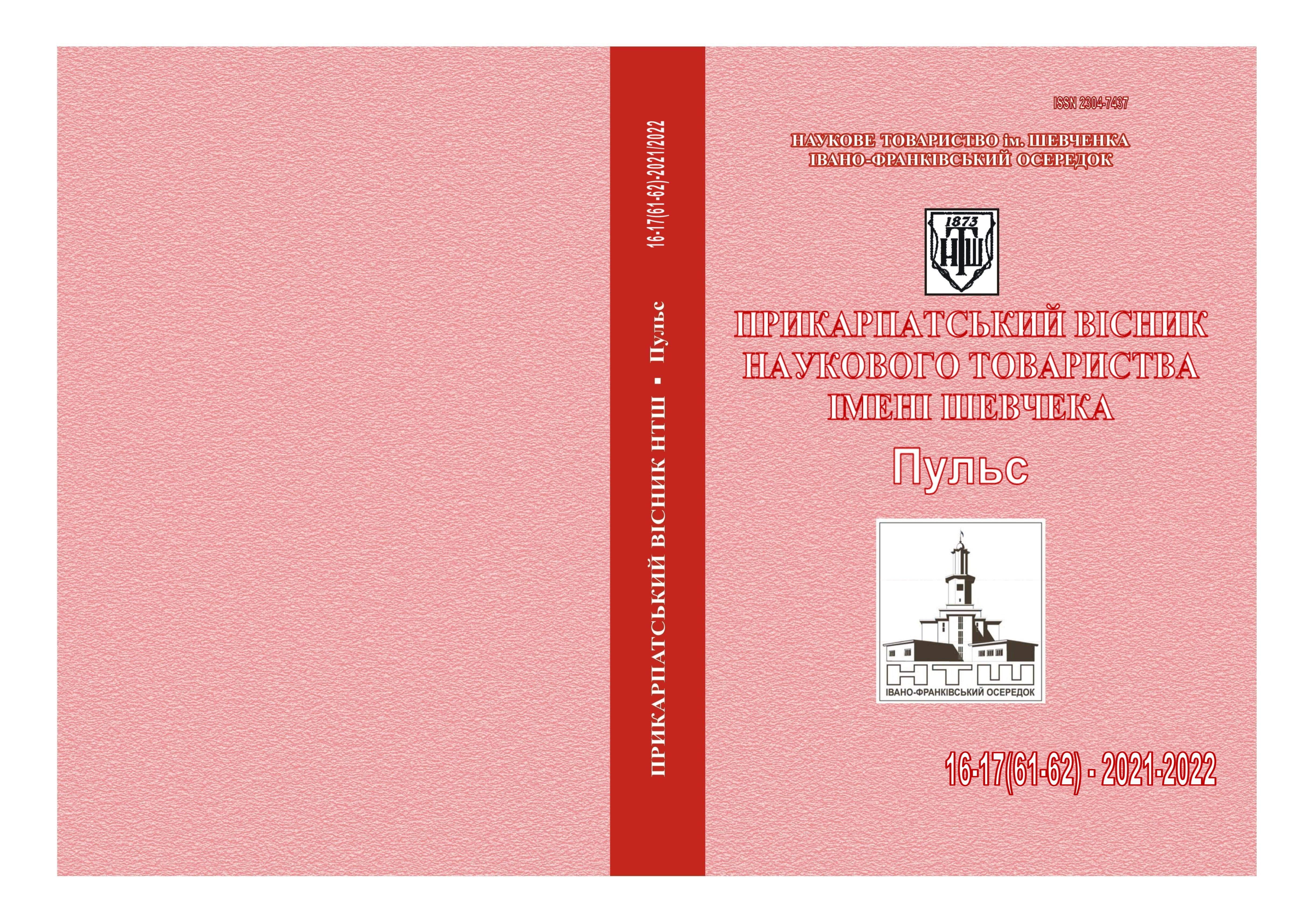THE FUNCTIONAL STATE OF LIVER IN PATIENTS WITH METABOLIC SYNDROME WITH TYPE 2 DIABETES
DOI:
https://doi.org/10.21802/2304-7437-2021-2022-16-17(61-62)-84-92Keywords:
type 2 diabetes mellitus, metabolic syndrome, insulin resistance, nonalcoholic fatty liver disease.Abstract
One of the pathogenetic mechanisms of the development of insulin resistance (IR) in type 2 diabetes mellitus (type 2 DM) is the formation of non-alcoholic fatty liver disease (NAFLD). DM and liver pathology can be considered as interrelated processes. The aim of the study was to evaluate the indicator, secretory and excretory enzymes of blood serum in the development of IR in patients with metabolic syndrome (MS) with type 2 DM. The distribution of patients with MS with type 2 DM was carried out, depending on the presence of non-alcoholic steatohepatitis (NASH): a group of patients with NASH - 36, a group of patients without NASH - 32. The degree of IR was determined by the size of the waist circumference, IR indices: HOMA-IR index and Caro index. The obligatory volume of laboratory researches included: the general clinical analysis of blood and urine, research of fasting blood glucose and postprandial glycemia, glycemic profile of blood by glucose oxidase method by means of the «Exan» device was carried out. Glycated hemoglobin (HbA1c) was determined by chromatographic method using a test system (fully automated analyzer) to determine the content of hemoglobin D-10TM by "Bio-Rad" company (USA). Determination of the activity of aspartate aminotransferase, alanine aminotransferase, lactate dehydrogenase, arginase, cholinesterase was performed by diagnostic kits of the Czech company "Lachema" on a spectrophotometer Sf-46. Alkaline phosphatase activity was determined by Phillips-Diagnostic reagent kits. The concentration of endogenous insulin was determined by DRG reagent kit (USA), by enzyme-linked immunosorbent assay using an analyzer "StatFax - 303. To determine the presence of structural changes in the liver the ultrasound on the device "Elegra" Simens Medicol Systems was used. Wefound that the metabolic prerequisites for the development of NASH of the liver are fasting and postprandial hyperglycemia, hyperinsulinemia. The increase in the degree of glycation of hemoglobin and increase in IR. The results of the study of the degree of hemoglobin glycation showed a reliable increase in the relative content of HbA1c in patients with NASH and MS with type 2 diabetes without NASH - 2.1 and 1.9 times, compared with healthy individuals. A study of the content of endogenous insulin in the blood on an empty stomach revealed reliable hyperinsulinemia - in patients with NASH, the content of endogenous insulin on an empty stomach exceeded the norm by 4.3 times. Increased levels of alanine aminotransferase, sorbitol dehydrogenase, arginase, lactate dehydrogenase, alkaline phosphatase and decreased cholinesterase in patients with MS with NASH detected which display the damage of detoxification and synthetic function of the liver and glycogenization. The connection of IR with the deepening of the phenomena of hepatocyte damage, suppression of the synthetic function of hepatocytes, with markers of nonspecific hepatodepsy, reduction of liver detoxification function, glycolysis processes, predictors of necrosis hepatocytes in NASH on the background of MS with type 2 DM determined.
References
Боднар П, Михальчишин Г, Кобиляк Н. Неалкогольна жирова хвороба печінки у хворих на цукровий діабет типу 2: патогенез, діагностика та лікування. Ендокринологія. 2012;17:94–101.
AlbertiK. G., Zimmet P., Shaw J. Forthe IDF Epidemiology Task Force Consensus Group. The metabolic syndrome – anew worl dwidedefinition. Lancet. 2005;366:1059–62.
Carr RM, Oranu A, Khungar V. Nonalcoholic Fatty Liver Disease: Patho-physiology and Management. Gastroenterology Clinics of North America. 2016;45:639–52.
Charlton MR, Burns JM, Pedersen RA, Watt KD, Heimbach JK, Dierkhising RA Frequency and outcomes of liver transplantation for nonalcoholic steatohepatitis in the United States. Gastroenterology. 2011; 141:1249–1253.
Cotter TG, Rinella M. Nonalcoholic Fatty Liver Disease. The State of the Disease. Gastroenterology. 2020;158:1851–64.
Ekstedt M, Franzén LE, Mathiesen UL, Thorelius L, Holmqvist M, Bodemar G, Kechagias S. Long-term follow-up of patients with NAFLD and elevated liver enzymes. Hepatology. 2006;44:865–73.
Ertle J, Dechêne A, Sowa JP, Penndorf V, Herzer K, Kaiser G, Schlaak JF, Gerken G, Syn WK, Canbay A. Non-alcoholic fatty liver disease progresses to hepatocellular carcinoma in the absence of apparent cirrhosis. International Journal of Cancer. 2011;128:2436–43.
Knebel B, Fahlbusch P, Dille M, et al. Fatty Liver Due to Increased de novo Lipogenesis: Alterations in the Hepatic Peroxisomal Proteome. Frontiers in Cell and Developmental Biology.2019;7:248.
Parthasarathy G, Revelo X, Malhi H. Pathogenesis of Nonalcoholic Stea-tohepatitis: An Overview. Hepatology Communications. 2020;4:478–92.
Perumpail BJ, Khan MA, Yoo ER, Cholankeril G, Kim D, Ahmed А. Clinical epidemiology and disease burden of nonalcoholic fatty liver disease. World Journal of Gastroenterology. 2017;23:8263–76.
Saeedi P, Petersohn I, Salpea P, et al. Global and regional diabetes prevalence estimates for 2019 and projections for 2030 and 2045: Results from the International Diabetes Federation Diabetes Atlas, 9th edition. Diabetes Research and Clinical Practice 2019;157:107-843.
Sanders FWB, Griffin JL De novo lipogenesis in the liver in health and disease: More than just a shunting yard for glucose. Biological Reviews.2016;91:452-68.
WHO | Global report on diabetes. https://www.who.int/diabetes/global-report/en/. Accessed 30 Jun 2020
Younossi ZM. Non-alcoholic fatty liver disease – A global public health perspective. Journal of Hepatology. 2019;70:531–44.

